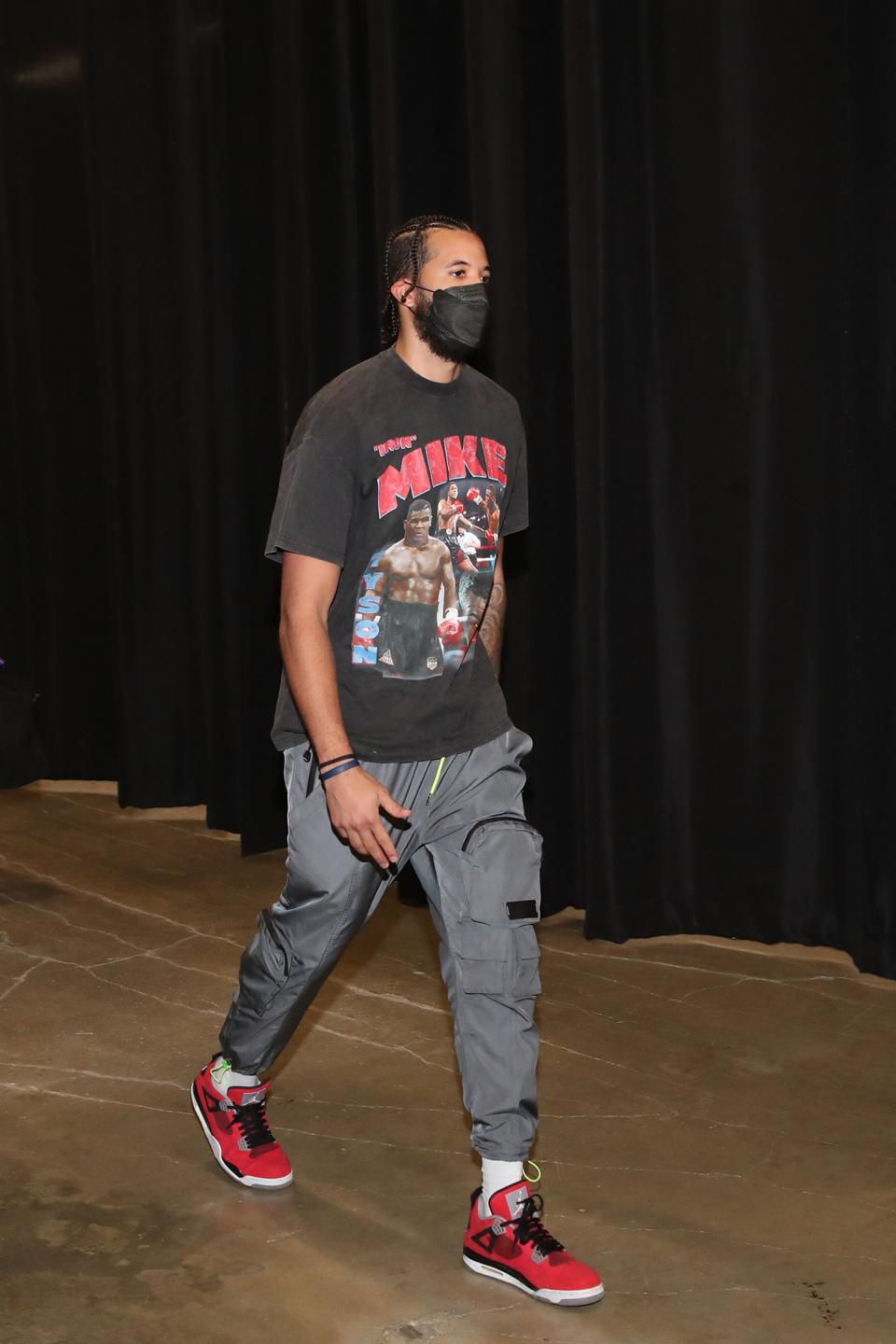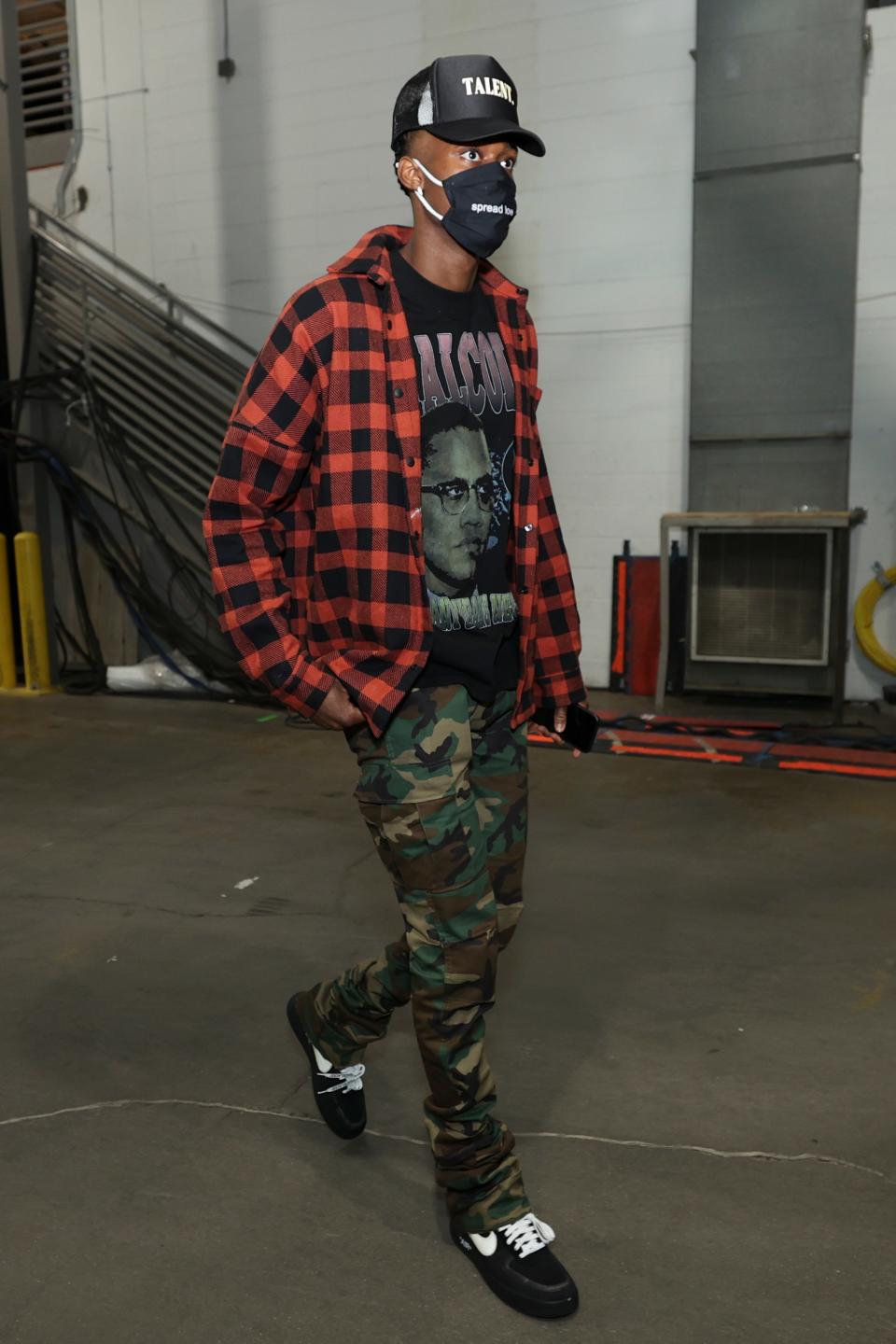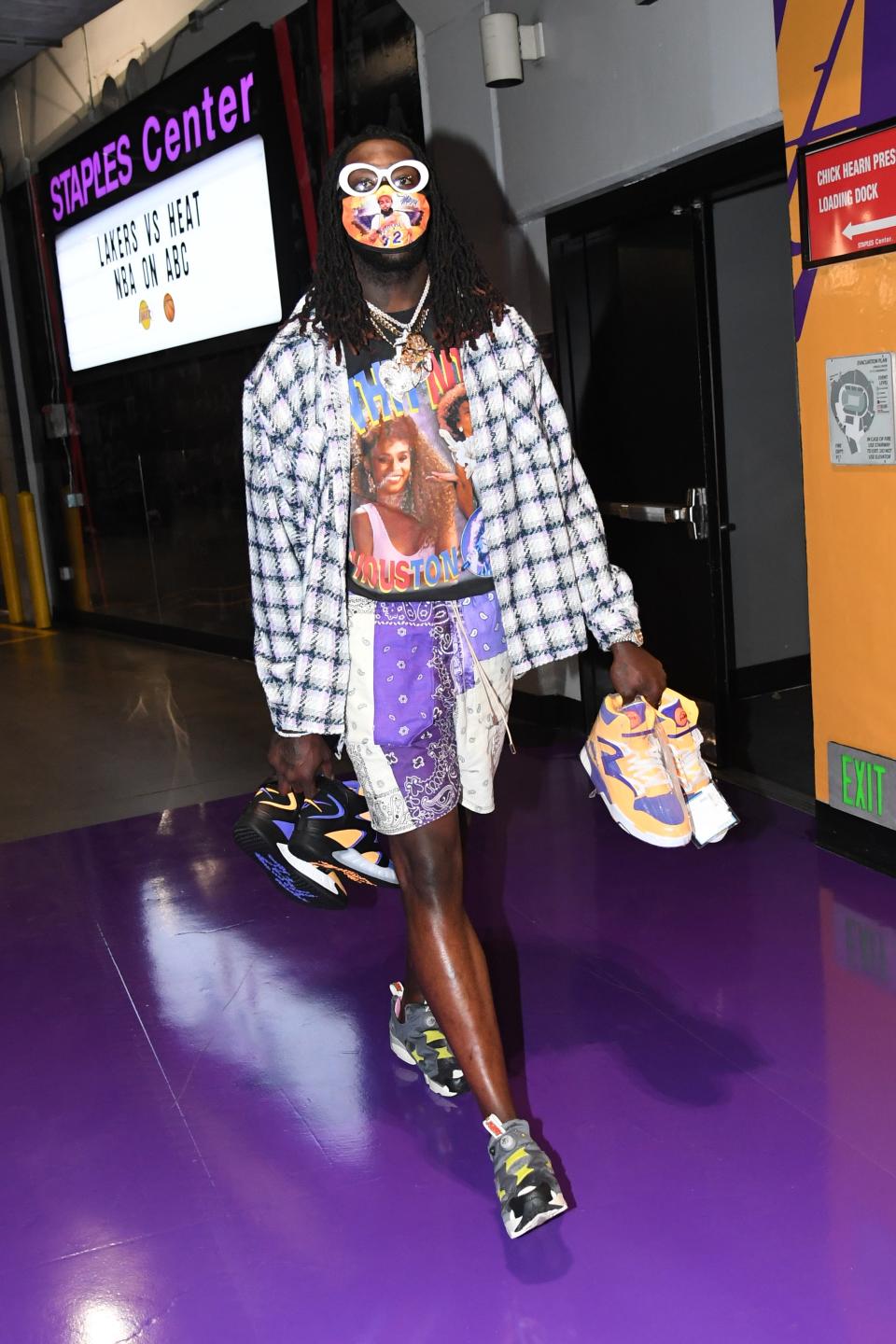The Rise of the Faux Bootleg Tee
In the much-observed NBA tunnel this season, basketball players far and wide have been following an unlikely trend: It looks like superstars from around the league have been plundering thrift stores for bootleg tees from the recesses of the late 1990s.
You might have seen Montrezl Harrell with a blown-out photograph of Whitney Houston gaudily emblazoned on his chest, or maybe Jarred Vanderbilt before a Timberwolves game rocking the words “ALLEN IVERSON” in oversize balloon letters. A few weeks ago, Tobias Harris of the 76ers stepped out wearing a faded Jackie Robinson tee that had the lost-in-time look of a once-in-a-lifetime Salvation Army find. Along with a fresh pair of Jordans and Chrome Hearts sweats, this kitschy relic of another era is the hottest trend in the NBA right now.

Orlando Magic v Miami Heat
Except these aren’t actually relics—perhaps unsurprisingly, your favorite star point guards aren’t spending their downtime rooting through thrift-store bargain bins. Instead, the goods come from several boutique T-shirt companies specializing in mock-vintage graphic tees, each meticulously and laboriously crafted to look as close to authentic, old-school styles as possible. Loaded with bright, garish colors and intentionally gaudy typefaces, they’re meant to look like they came from the back of a rack in a market in Chinatown circa 1998. It’s vintage bootleg kitsch—the more lurid and flashy, the better.
“I think the reason our shirts look the way they do is because I don’t have an actual Photoshop background,” says Jonny Weitz, who cofounded the bootleg-tee company Grace Court Co with his friend and business partner, Brandon Pollack. Weitz’s extremely (and charmingly) amateur designs, which he creates himself at home on his computer, look like a combination of homemade trading cards and high school graduation photos circa 1993—a whole lot of dorky, out-of-context pics layered on top of one another haphazardly.
It’s odd, but it really works—and the reason, he insists, is because he doesn’t really know what he’s doing. “People who know how to use Photoshop look at what color schemes work well together, or which typography works with that typography,” he says. “I just use my eye. And I’m colorblind.”
Weitz and Pollack started making their own tees on a whim in the early days of quarantine, putting up an Instagram page for fun to see what would happen. It started to blow up, Pollack explains, after Caris Lavert, then of the Brooklyn Nets, wore one of their shirts to a protest and photos of his ensemble made the rounds online. “Basketball guys are pushing the culture of fashion, and they’re not scared to look crazy,” Pollack says. “Their streetwear gets broadcast around social media, and we’d have nothing without that.” Grace Court tees have since popped up on hoopers Tyrese Maxey, Hamidou Diallo, Terance Mann, and Bruce Brown, making his tees some of the most in-demand in the league.

Memphis Grizzlies v Minnesota Timberwolves
DAPS Retro likewise started as a lockdown pastime. Dion Sadiku and Adam Puccio, friends based in Australia, were “just locked inside and isolated and bored” last year, Puccio explains. He watched a video on TikTok of someone ironing a picture of Stone Cold Steve Austin onto a plain T-shirt, and he figured he would give it a try. “We did it more or less as a joke at the start, because we were bored. But we let our creative juices flow and followed through with it, and we’re really happy with how it turned out,” Sadiku says. “It was born out of simplicity, really. It was too simple not to do it.”
That experiment expanded into a line of ultra-garish styles featuring the visages of rappers such as Young Thug and Lil Uzi Vert, and basketball players like Vince Carter and Kobe Bryant. They’ve had the most success, though, combining their trashy, over-the-top retro aesthetic with new faces from the NBA, especially rookie of the year frontrunner LaMelo Ball. “Everyone, but especially our demographic, loves LaMelo Ball,” Puccio says. “Seeing him on an old-school-style T-shirt, with those Hornets colors, it just works so well.” There is something irresistibly dissonant about seeing the young LaMelo in this very specific aesthetic context, which feels like it belongs so firmly to a particular place and time. The uncanny effect is key to the fake bootleg shirt’s entire appeal.
By far the biggest name in the bootleg-tee game right now is Do Not Disturb, the Atlanta-based streetwear brand owned and operated by fashion designer Ferris, whose shirts are staples in the wardrobes of Young Thug and LeBron James, among many, many others. But Ferris is keen to point out that, as a brand, Do Not Disturb has endeavored to be very socially conscious—and their messaging makes them stand out.
“That’s always really been the main focus of everything that we do,” Ferris says. “We love that retro, hip-hop, bootleg, faux-vintage style, but we tried to figure out a way to incorporate that style and tell a story with the T-shirt at the same time.” To that end, Do Not Disturb has a line of bootleg-style shirts featuring Black leaders and political figures, including Rosa Parks and Martin Luther King Jr. “We are a Black-owned brand,” Ferris says. “We’re trying to teach the kids that it’s cool to wear a historical figure.”
Ferris’s favored aesthetic involves many of the unforgettably tasteless hallmarks of the late ’90s and early 2000s: hot-pink airbrushed graffiti, glittering cursive typefaces, incongruous images, and colors gaudily mashed together. He’s made memorial T-shirts for Aaliyah and Kobe Bryant—“IN LOVING MEMORY”—that look, in the best way, like something your grandmother might have had custom-made at a booth in the mall, replete with a smattering of doves.

Miami Heat v Los Angeles Lakers
These styles edge so close to ugly that they become almost inexplicably cool. Ferris says nailing that look without going too far is always something of a balancing act. “Do we want it to be cool, or do we want it to be cheesy? Putting those things together, the style, the colors, the fonts, it’s a recipe. It’s tough to explain exactly what it is that works,” he says. “But that’s what it’s all about. Taking your own road, doing your own thing.”
There’s certainly something about the trend that feels distinctly of the moment—a moment when nostalgia for the halcyon days of the early to mid-1990s has never been more intense or more widespread, and when we’re seriously wondering whether the much-derided styles seen off-court across the NBA in that era weren’t actually cool all along. It’s also notable that the popularity of this aesthetic is being driven largely by Instagram, where throwback fit pics and retro-oriented mood boards have us clamoring for our own piece of the past. As NBA players continue to delve into the work of amateur designers on social media—and as pics of those stars wearing these shirts continue to be posted and shared like mad—the trend is only going to keep blowing up.
Originally Appeared on GQ

